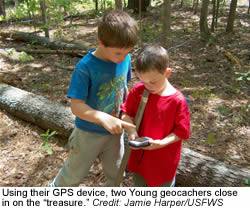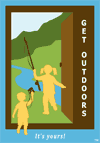
|
Treasure Hunting
Using their GPS device, two Young geocachers close in on the “treasure.” Janell Lovelace’s three-year old son, Bram, is an experienced treasure hunter. And we’re not just talking pretend treasures, either. Bram hikes through forests and down trails until his parents’ Global Positioning System (GPS) lets his family know they’re getting close to the treasure they’re seeking. Once they’re close enough, Bram rummages among the fallen leaves and peers into tree stumps, until—eureka! Hidden treasure! The Durham, North Carolina family is part of a growing worldwide trend—geocaching. This new-age combination of orienteering and hide-and-seek gets families around the world out and hiking together. Here’s how it works: Someone hides a treasure box (“cache”) and notes its coordinates—its unique position on the globe. Then, they post those coordinates online at www.geocaching.com, along with an optional clue. Other geocachers can then use their own GPS systems to track down the cache. It’s not as easy as it sounds, though. The GPS will only get you so close, and then it’s up to old-fashioned detective work to find the cache itself, usually a sealed rubber container or army ammo box. Inside, treasure hunters will find a logbook to sign and date, and an assortment of trinkets to choose from. They then replace the loot with a trinket of their own—small toys, CDs, movies, books, and such—and carefully hide the container back in the same place for the next player to find. Traditional caches are located all over the world. But since leaving behind a cache in federal wildlife refuges is illegal, there’s another component to geocaching that entices participants to these wonderful wildlife areas: Virtual caching. With a virtual cache, participants use clues, GPS waypoints and landmarks to get themselves to a particular spot in the reserve. Clever virtual caches can include amazing scenic spots, lesser-known public trails, key bird watching spots, locations of natural mineral deposits, or other natural wonders. It’s low-impact treasure hunting at its best. To assist local cachers, rangers at the Upper Mississippi River National Wildlife and Fish Refuge in Minnesota created a special virtual cache with multiple locations and questions. When cachers complete the entire circuit, they return to the headquarters to report back and collect a reward. Cachers have been amazed at the wildlife they’ve spotted and thrilled to discover new trails they’d previously overlooked. For families, geocaching is just the ticket to get outdoors and explore nature—what kid could resist a treasure hunt? An added benefit of virtual cache: It helps kids really look closely at nature’s beauty as they work the clues and seek out natural landmarks. For your first few caches with the kids, look for caches that are easy to find and in easy terrain (they’re clearly marked online). If you’re choosing your destinations from the online site, read through the log entries to see if other people have had a lot of difficulty getting to the cache. Bushwhacking with young children can be a quick way to a frustrating outing. Many geocachers keep a backpack just for geocaching, loaded with what they need, so they can just grab it and go when the urge for adventure hits. Stock your bag with your GPS unit, a local map, flashlight, bug sprays, pens, small first aid kit, and binoculars for checking out the nature scenes. Geocaching is not only fun, but it’s a great way to get out and exercise as a family, too, says Maria Nardini, fitness manager of the Duke Health and Fitness Center in North Carolina. “When you’re hiking, especially in that kind of environment, there’s going to be a variety of terrain,” she says. “It’s a variety of ways to challenge the body. You may be climbing a steep hill, which is an interval workout, and then return to flat ground, where you’re getting a good cardiovascular benefit.” One of the best rules of geocaching gives kids a hands-on way to care for the environment, too: Cache In, Trash Out. In an effort to preserve and improve the natural areas of the world, geocachers are asked to tread lightly on the land—and actually help improve it, too—by bringing along a bag to remove any litter you come across in your outings. It’s not only helping the environment, but it’s setting a great example for your children. “We’ve carried out dozens of bags of trash from public parks over the past year,” Lovelace says. Getting out in search of treasure returns a sense of outdoor adventure to our world dominated with indoor entertainment, and families across the country are enthusiastically jumping into geocaching. And it’s helping their families grow closer, too. “A family that does this kind of activity together is likely to support each other in other types of activities, too, and will continue to do so long-term,” says Nardini. And that’s one treasure you’ll always keep close. Kathleen M. Reilly is a freelance writer in North Carolina. She and her family are avid geocachers. |
Last updated:
December 19, 2008




